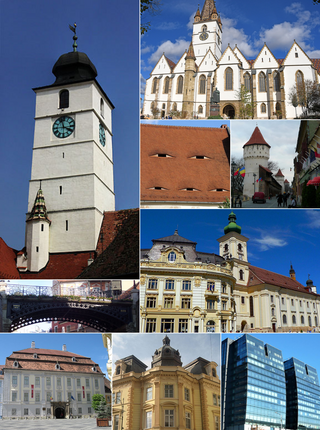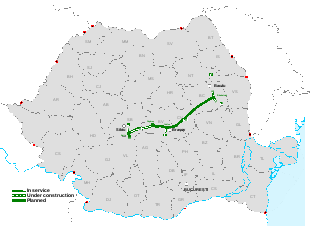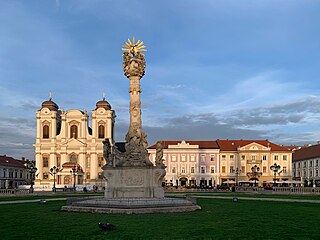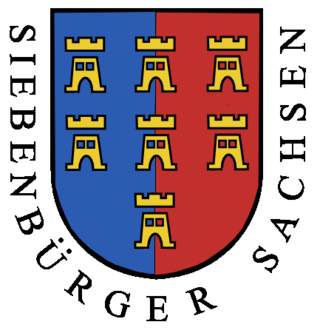
Timișoara is the capital city of Timiș County, Banat, and the main economic, social and cultural centre in Western Romania. Located on the Bega River, Timișoara is considered the informal capital city of the historical Banat. From 1848 to 1860 it was the capital of the Serbian Vojvodina and the Voivodeship of Serbia and Banat of Temeschwar. With 250,849 inhabitants at the 2021 census, Timișoara is the country's fifth most populous city. It is home to around 400,000 inhabitants in its metropolitan area, while the Timișoara–Arad metropolis concentrates more than 70% of the population of Timiș and Arad counties. Timișoara is a multicultural city, home to 21 ethnic groups and 18 religious denominations. Historically, the most numerous were the Swabian Germans, Jews and Hungarians, who still make up 6% of the population here.

Brașov County is a county (județ) of Romania, in Transylvania. Its capital city is Brașov. The county incorporates within its boundaries most of the Medieval "lands" (țări) Burzenland and Făgăraș.

Sibiu County is a county of Romania, in the historical region of Transylvania. Its county seat is the namesake town of Sibiu.

Argeș County is a county (județ) of Romania, in Muntenia, with the capital city at Pitești.

Sibiu is a middle-sized, well-preserved fortified medieval town in central Romania, situated in the historical region of Transylvania. Located some 275 km (171 mi) north-west of Bucharest, the town straddles the Cibin River, a tributary of the Olt River. Now the county seat of the Sibiu County, between 1692 and 1791 and 1849–65 Sibiu was the capital of the Principality of Transylvania. During the Modern era, the Hecht hause in Sibiu served as the seat of the Transylvanian Saxon University.

The A1 motorway is a partially built motorway in Romania, planned to connect Bucharest with the Banat and Crișana regions in the western part of the country and the rest of Europe. When completed it will be 581 kilometers long and it will span the country on the approximative south-east to north west direction. The motorway starts in the western part of Bucharest and connects the following major cities: Pitești, Sibiu, Deva, Timișoara, Arad, reaching Hungary's M43 motorway near Nădlac. As the motorway is built along the Trans-European Transport Networks Rhine-Danube Corridor the construction receives 85% funding from the European Union. The road is part of the proposed Via Carpatia route.

The Olt is a river in Romania. It is 615 km (382 mi) long, and its basin area is 24,050 km2 (9,290 sq mi). It is the longest river flowing exclusively through Romania. Its average discharge at the mouth is 174 m3/s (6,100 cu ft/s). It originates in the Hășmaș Mountains of the eastern Carpathian Mountains, near Bălan, rising close to the headwaters of the river Mureș. The Olt flows through the Romanian counties of Harghita, Covasna, Brașov, Sibiu, Vâlcea, and Olt. The river was known as Alutus or Aluta in Roman antiquity. Olt County and the historical province of Oltenia are named after the river.

Romania's tourism sector had a direct contribution of EUR 5.21 billion to the Gross Domestic Product (GDP) in 2018, slightly higher than in 2017, placing Romania on the 32nd place in the world, ahead of Slovakia and Bulgaria, but behind Greece and the Czech Republic. The total tourism sector's total contribution to Romania's economy, which also takes into account the investments and spending determined by this sector, was some EUR 15.3 billion in 2018, up by 8.4% compared to 2017.

The Germans of Romania represent one of the most significant historical ethnic minorities of Romania since the late modern period onwards.

The Cârța Monastery is a former Cistercian (Benedictine) monastery in the Țara Făgărașului region in southern Transylvania in Romania, currently an Evangelical Lutheran church belonging to the local Saxon community. It lies on the left bank of the Olt River, between the cities of Sibiu and Făgăraș, close to the villages of Cârța and Cârțișoara. The monastery was probably founded in 1202–1206 by monks from Igriș Abbey, and was disbanded in 1494, when the apostolic legate Ursus of Ursinis ratified Cârța Abbey's attachment to the Provostship nullius of Sibiu. The Cistercian monastery introduced and helped develop French Gothic art in the region.
The Democratic Forum of Germans in Romania is a political party organised on ethnic criteria representing the interests of the German minority in Romania.

The Romanian government is the armiger in Romania. It exercises this right under the mandatory advice of the National Committee of Heraldry, Genealogy and Sigillography. The committee is subordinate to the Romanian Academy. All the coats of arms of Romanian institutions must be approved by this committee with two exceptions. The Romanian military is subject to the Ministry of National Defense Heraldric Committee, and Romanian law enforcement institutions are subject to the Ministry of Administration and Interior Heraldric Committee. Both of these committees may share members with the National Committee of Heraldry, Genealogy and Sigillography.

The Lutheran Cathedral of Saint Mary is the most famous Gothic-style church in Sibiu, Transylvania, central Romania. Its massive 73.34 m high steeple is a landmark of the city. The four turrets situated on top of the steeple are said to have been a sign to let foreigners know that the town had the right to sentence to death. It belongs to the Lutheran, German-speaking Evangelical Church of Augustan Confession in Romania.

Arad Central railway station is the largest railway station in the city of Arad, and the largest in the Arad County. It is the second largest railway station in the western region of Romania, immediately after Timișoara Nord railway station.

The Sibiu–Brașov–Bacău Motorway is a planned motorway in the central part of Romania, designed to connect Sibiu and Bacău counties, via Brașov. The project is currently regarded as composed of three sections Boița – Făgăraș, Făgăraș – Brașov, and Brașov – Răcăciuni, planned to be 282 kilometres (175 mi) long.

Asociația Fotbal Club Hermannstadt, commonly known as FC Hermannstadt, Hermannstadt or familiarly as Sibiu, is a Romanian professional football club based in the city of Sibiu, Sibiu County, which currently competes in Liga I.

Făgăraș County is one of the historic counties of Transylvania, Romania. The county seat was Făgăraș.
Alexandru Pelici is a Romanian former professional footballer and currently a manager. He was most recently in charge of Liga I club Mioveni.

Union Square, also known as Dome Square, is the oldest square in Timișoara. It was named in honor of the Romanian troops that entered Timișoara on 3 August 1919 and established the Romanian administration, thus finalizing the union of Banat with Romania. Initially, it was called Losonczy Square, after Count István Losonczy who was killed by the Turks in 1552, when the fortress was conquered.

The Transylvanian Saxon University was an official governing body of the Transylvanian Saxon community in Transylvania during the Late Middle Ages up until the late Modern Age. The Saxon University was led by the Saxon Count.




































